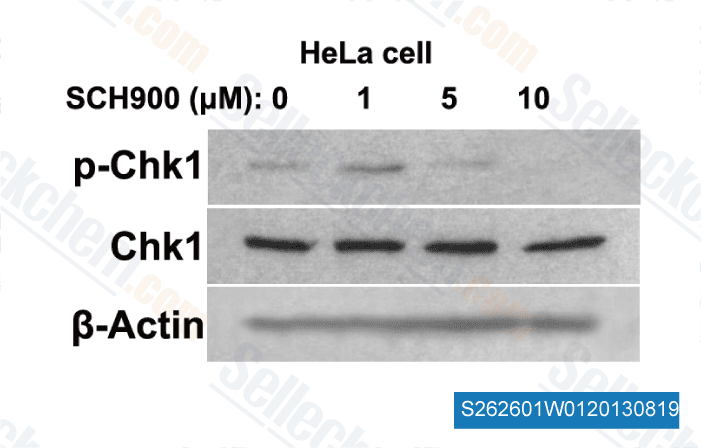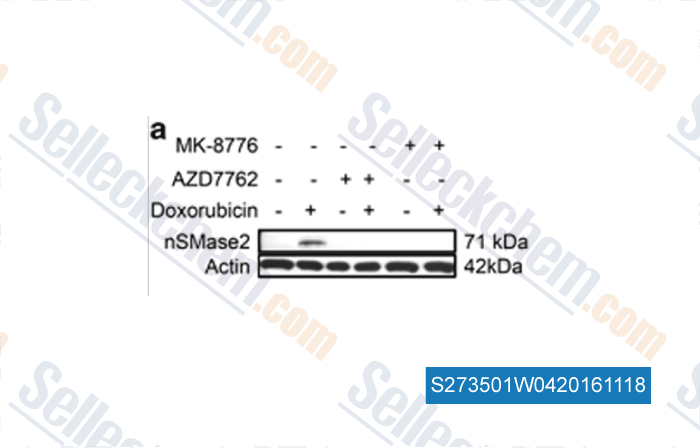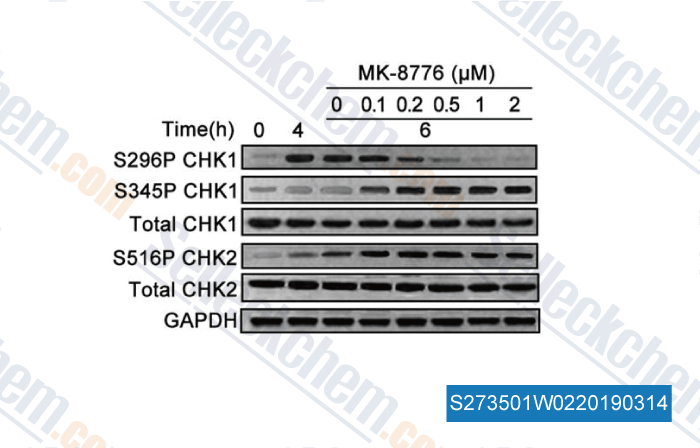|
Toll Free: (877) 796-6397 -- USA and Canada only -- |
Fax: +1-832-582-8590 Orders: +1-832-582-8158 |
Tech Support: +1-832-582-8158 Ext:3 Please provide your Order Number in the email. |
Technical Data
| Formula | C15H18BrN7 |
||||||
| Molecular Weight | 376.25 | CAS No. | 891494-63-6 | ||||
| Solubility (25°C)* | In vitro | DMSO | 75 mg/mL (199.33 mM) | ||||
| Ethanol | 60 mg/mL (159.46 mM) | ||||||
| Water | Insoluble | ||||||
| In vivo (Add solvents to the product individually and in order) |
|
||||||
|
* <1 mg/ml means slightly soluble or insoluble. * Please note that Selleck tests the solubility of all compounds in-house, and the actual solubility may differ slightly from published values. This is normal and is due to slight batch-to-batch variations. * Room temperature shipping (Stability testing shows this product can be shipped without any cooling measures.) |
|||||||
Preparing Stock Solutions
Biological Activity
| Description | MK-8776 (SCH 900776) is a selective Chk1 inhibitor with IC50 of 3 nM in a cell-free assay, showing 500-fold selectivity against Chk2. It is in Phase 2. | ||||
|---|---|---|---|---|---|
| Targets |
|
||||
| In vitro | MK-8776 (SCH 900776) is a less potent inhibitor of Chk2 and CDK2 with IC50 of 1.5 μM and 0.16 μM, respectively. It shows no significant inhibition of cytochrome P450 human liver microsomal isoforms 1A2, 2C9, 2C19, 2D6, and 3A4. In combination with an antimetabolite, this compound induces accumulation of γ-H2AX within 2 hours, indicative of replication fork collapse and double stranded DNA breaks. Additionally, it suppresses accumulation of the Chk1 pS296 autophosphorylation in a dose-dependent manner. Exposure of proliferating WS1 cells to SCH 900776 is associated with rapid, dose-dependent accumulation of Chk1 pS345, indicating that cycling populations of normal cells induce Chk1 pS345 following exposure to it as part of a futile cycle, perhaps driven by AT-family kinases and DNA-PK.[1] |
||||
| In vivo | Dose escalation of MK-8776 (SCH 900776) (16 mg/kg and 32 mg/kg) induces incremental improvements in tumor response. Importantly, doses of this compound associate with robust biomarker activation and improved tumor response are not associated with enhanced toxicity on hematological parameters in BALB/c mice. [1] |
Protocol (from reference)
| Kinase Assay: |
|
|---|---|
| Cell Assay: |
|
| Animal Study: |
|
References
|
Customer Product Validation

-
,

-
Data from [ , , Biomaterials, 2018, 182:35-43 ]

-
Data from [ , , Cell Death Dis, 2015, 6:e1947. ]

-
Data from [ , , Sci Rep, 2017, 7(1):15031 ]
Selleck's MK-8776 (SCH 900776) Has Been Cited by 85 Publications
| The DNA replication checkpoint prevents PCNA/RFC depletion to protect forks from HLTF-induced collapse in human cells [ Mol Cell, 2025, 85(13):2474-2486.e6] | PubMed: 40578346 |
| Combined MEK and PARP inhibition enhances radiation response in rectal cancer [ Cell Rep Med, 2025, 6(8):102284] | PubMed: 40782795 |
| Combined therapy with DR5-targeting antibody-drug conjugate and CDK inhibitors as a strategy for advanced colorectal cancer [ Cell Rep Med, 2025, S2666-3791(25)00231-9] | PubMed: 40449480 |
| WIP1 mutations suppress DNA damage triggered bypass of the mitotic timer [ EMBO J, 2025, 10.1038/s44318-025-00495-0] | PubMed: 40551011 |
| Targeting Chk1 and Wee1 kinases enhances radiosensitivity of 2D and 3D head and neck cancer models to X-rays and low/high-LET protons [ Cell Death Dis, 2025, 16(1):128] | PubMed: 39994186 |
| Nuclear PD-L1 triggers tumour-associated inflammation upon DNA damage [ EMBO Rep, 2025, 10.1038/s44319-024-00354-9] | PubMed: 39747659 |
| MK-8776 and Olaparib Combination Acts Synergistically in Hepatocellular Carcinoma Cells, Demonstrating Lack of Adverse Effects on Liver Tissues in Ovarian Cancer PDX Model [ Int J Mol Sci, 2025, 26(2)834] | PubMed: 39859548 |
| Synthetic Lethal Combinations of DNA Repair Inhibitors and Genotoxic Agents to Target High-Risk Diffuse Large B Cell Lymphoma [ Hematol Oncol, 2025, 43(5):e70131] | PubMed: 40847617 |
| Oncogenic p53 induces mitotic errors in lung cancer cells by recopying DNA replication forks conferring targetable proliferation advantage [ Res Sq, 2025, rs.3.rs-7303237] | PubMed: 40831504 |
| Precise nano-system-based drug delivery and synergistic therapy against androgen receptor-positive triple-negative breast cancer [ Acta Pharm Sin B, 2024, 14(6):2685-2697] | PubMed: 38828153 |
RETURN POLICY
Selleck Chemical’s Unconditional Return Policy ensures a smooth online shopping experience for our customers. If you are in any way unsatisfied with your purchase, you may return any item(s) within 7 days of receiving it. In the event of product quality issues, either protocol related or product related problems, you may return any item(s) within 365 days from the original purchase date. Please follow the instructions below when returning products.
SHIPPING AND STORAGE
Selleck products are transported at room temperature. If you receive the product at room temperature, please rest assured, the Selleck Quality Inspection Department has conducted experiments to verify that the normal temperature placement of one month will not affect the biological activity of powder products. After collecting, please store the product according to the requirements described in the datasheet. Most Selleck products are stable under the recommended conditions.
NOT FOR HUMAN, VETERINARY DIAGNOSTIC OR THERAPEUTIC USE.
